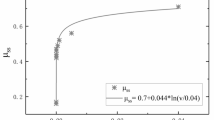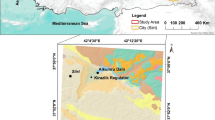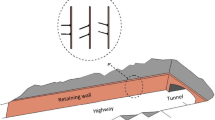Abstract
In existing researches connected with landslide, natural slope was regard as a parallel slope, but it was found that many landslides were occurred on the concave and convex slopes besides parallel slopes. This study was performed to evaluate the effect of shape and length of slope and soil depth for slope stability analysis and to compare infinite slope analysis with circular failure analysis for grid by grid analysis in prediction of GIS-based landslide hazard. As grid size is increased, average slope and curvature were decreased and the decreasing tendency was prominent in mountainous areas. Comparing infinite slope analysis and circular failure analysis for various degree of slope and soil depth, safety factor by infinite slope analysis is larger than that by circular failure analysis. Result showed that the factor safety depends on the shape of slope which is composed of two continuous slopes, if grid size is small (such as 5 m×5 m). So after due consideration for soil depth and topography, proper slope stability analysis must be performed.
Similar content being viewed by others
References
Bromhead, E. N. (1992). The stability of slopes, Blackie Academic & Professional.
Chae, J. H., Jeong, I. J., Shon, I. S. and Kim, S. Y. (2002). “A study on the slope analysis to grid size and error by division of small watershed.” KSCE Conference Proceedings, pp. 323–326 (in Korean).
KIGAM (2000). Prediction and mitigation of landslide hazards, Natural Hazard Prevention Research (in Korean).
Park, S. J., McSweeney, K., and Lowery, B. (2001) “Identification of the spatial distribution of soils using a process-based terrain characterization.” Geoderma, Vol. 103, pp. 249–272.
Rogers, C. T. and Sitar, N. (1993). Expert systems approach to regional evaluation of debris flow hazard, Geotechnical Engineering Report No. UCB/GT/93-08, Geotechnical Engineering Department of Civil Engineering, University of California, Berkeley.
Wu, T. H. and Abdel-Latif, M. A. (2000). “Prediction and mapping of landslide hazard.” Can. Geotech. J., Vol. 37, pp. 781–795.
Yang, I. T., Kim, Y. J. and Yu, Y. G. (2002). “An analysis of terrain slope and drainage basin area by DEM grid size.” Journal of Korean Society of Surveying, Geodesy, Photogrammetry, and Cartography. Vol. 20, No. 3, pp. 303–311 (in Korean).
Zevenberg, L. W. and Thorne, C. R. (1985). Fortran computer program TOPO, Dept. of Grography and Earth Science, Queen Mary College, University of London, London. U.K.
Author information
Authors and Affiliations
Corresponding author
Rights and permissions
About this article
Cite this article
Cha, KS., Kim, TH. Evaluation of slope stability with topography and slope stability analysis method. KSCE J Civ Eng 15, 251–256 (2011). https://doi.org/10.1007/s12205-011-0930-5
Received:
Accepted:
Published:
Issue Date:
DOI: https://doi.org/10.1007/s12205-011-0930-5




